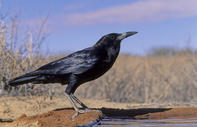
Name
Cape crow – Corvus capensis Alternative common name – black crowCape Crow Appearance
The Cape crow is around 50 cm in length. This crow is black throughout. The head, bill, legs, feathers and eyes are black. This is the only glossy black crow in the region.Cape Crow Diet
The Cape crow is omnivorous, with a broad range of food items including insects, lizards, termite alates (flying termites), frogs, tortoises, and domestic chickens. The Cape crow will also eat fruit and bulbs. It will scavenge at a carcass.Cape Crow Breeding
The Cape crow is monogamous. The female is mostly responsible for building a large nest from sticks that are brought to the nesting site by the male. The nest is built on shrubs, trees or transmission poles.
Two to three eggs are laid and are incubated by both parents for around 18 days, the young crows fledge at 30 to 40 days. The Cape crow is one of the main hosts of the greater spotted cuckoo. It is estimated that 10% of nests are parasitised.